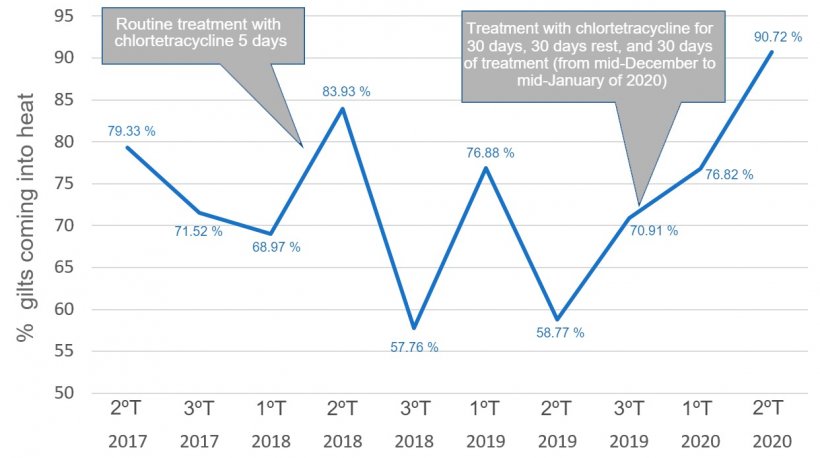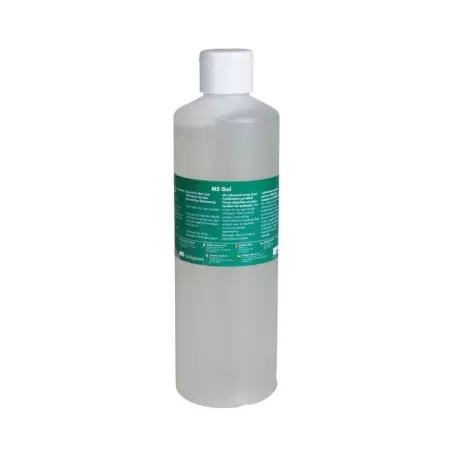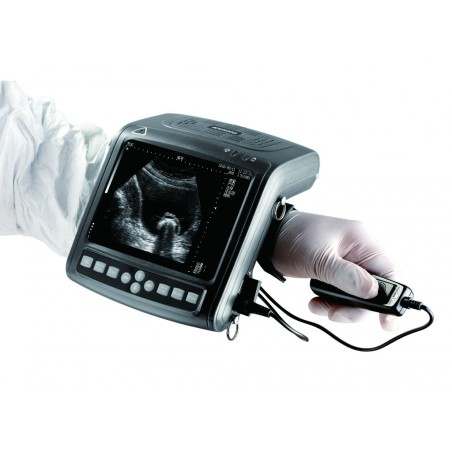Farm description
It is a farrow to finish 550 sow farm, it finishes out 50% of the production. The farm is producing its own self-replacement . The only animals entering the farm are the GP sows, 2 times/year, at two different weights (60 and 80 kg, between 120 - 160 days old). They are in quarentine at least 80 days before insemination. The farm is positive for PRRS, Mycoplasma, APP, influenza and Lawsonia.and negative for Aujeszky, atrophic rhinitis, and swine dysentery. The farm only has teaser boars: the semen doses are purchased from a PRRS-negative AI stud. The farm does 3-week batch management. The farm was built in the '70s and is located more than 500 m away from other farms. Many pigeons are often present on the roof of the buildings and external biosecurity is insufficient. When the GP sows arrive, they are kept isolated in a separate barn.

Replacement gilt management
The self-replacement gilts are kept separately (rooms/pens) from the comercial production starting at weaning. When they are weaned they go to a room with pens (10 weaner gilts per pen) or in rooms (30 weaner gilts per room) where they are housed until they reach 25 kg, and then they are moved to larger rooms with 40 gilts per pen. They are never mixed with the finishing animals. When they get to be about 60 kg they are moved to a barn which houses weaned pigs on one half (separated by a dividing door) and the other half house 120 gilts until they are moved to the service area, where altrenogest treatment is started to synchronize them with the batches. They are mated at about 150 kg with an average age of 8 months. Liquid feed is given 3 times per day, made with a feed that is complementing the corn meal.
Description of the problem
In the middle of 2016 the GP source farm was changed. Starting in 2017, a gradual decrease in the number of self-replacement gilts coming into heat was noted. Previously, after hormonal treatment with altrenogest, around 85-90% of the gilts came into heat and were mated with an excellent fertility rate that was even better than that of the multiparous sows. Starting in 2017 the gilts coming into heat (exhibiting the standing reflex) fell gradually until it leveled off at levels less than 50-60% of the matings. This situation caused a notable increase in the number of gilts introduced in each batch to maintain the appropriate number of matings, as well as overcrowing in the mating area and increasing the amount of work in stimulation during the period of preparation and heat detection. No less important is the increase in production costs. This problem of lack of estrous affected only the self replacement gilts . The GP gilts did not exhibit any problems during this period.
In the adult sows there were no significant anestrous problems detected.
Fertility data was normal (Table 1):
Table 1. Performance trend analysis.
| Information on the matings | ||||||||||||
|---|---|---|---|---|---|---|---|---|---|---|---|---|
| 2011 | 2012 | 2013 | 2014 | 2015 | 2016 | 2017 | 2018 | 2019 | 2020* | Total | Average | |
| Total inseminations | 1388 | 1281 | 1391 | 1480 | 1418 | 1344 | 1466 | 1426 | 1501 | 730 | 13425 | 1342 |
| (as % of total) | 10.3% | 9.5% | 10.4% | 11.0% | 10.6% | 10.0% | 10.9% | 10.6% | 11.2% | 5.4% | ||
| First service | 1168 | 1179 | 1251 | 1325 | 1246 | 1199 | 1321 | 1297 | 1395 | 647 | 12028 | 1203 |
| • gilts | 270 | 317 | 335 | 268 | 309 | 268 | 393 | 375 | 355 | 181 | 3071 | 307 |
| (% of all first services) | 23.1% | 26.9% | 26.8% | 20.2% | 24.8% | 22.4% | 29.8% | 28.9% | 25.4% | 28.0% | 25.5% | |
| • sows | 894 | 858 | 911 | 1055 | 932 | 916 | 899 | 899 | 1014 | 454 | 8832 | 883 |
| Inseminations with returns | 220 | 102 | 140 | 155 | 172 | 145 | 145 | 129 | 106 | 83 | 1397 | 140 |
| Rate of return to estrus | 15.9% | 8.0% | 10.1% | 10.5% | 12.1% | 10.8% | 9.9% | 9.0% | 9.0% | 11.4% | 10.4% | |
| Fertility | 75.4% | 84.6% | 83.9% | 82.3% | 77.7% | 81.3% | 77.9% | 80.0% | 80.0% | 82.1% | 80.4% | |
| Average age at mating (parity) | 2.7 | 2.3 | 2.1 | 2.6 | 2.4 | 2.6 | 2.2 | 2.1 | 2.3 | 2.2 | 2.4 | |
Critical points in management and actions taken:
- Early 2017. Until this time no particular problems were noted. In 2016 young vasectomized boars were used in the gilt pen, 3 weeks before entering mating, when they were syncronized with altrenogest. At one point, the boars no longer came into contact with gilts of reproductive age (180-210 days), but rather with younger gilts (130-160 days). The reason was that the floor was solid and slippery and the boars and gilts could get hurt if they were held together. The initial concern was that (as shown) the presence of the boars in contact with the very young gilts could alter their correct reproductive development. Finally, the boars were completely removed from the pens and it was recommended that all gilts of reproductive age (6 months and older) be stimulated once a day, with the boars entering the pen and the first signs of estrus marked.
- Mid-2017. During monitoring, PRRSv viremia was found in the gilts during the "altrenogest" treatment period. Historically, all gilts entering gestation were negative (PCR and oral fluids). The discovery of this viral circulation in this phase lead to an attempt to generate more immunity in the gilts; they were left together (in the same pen) with the finishing piglets from weaning until 140 days. After many months (when these gilts reached mating) it was found that this solution did not resolve the problem, and the farm went back to managing the gilts separately from the finishing animals.
- Late 2017. An analysis was carried out to detect the presence of mycotoxins in the feed, revealing high levels of DON . In addition, it was found that the silo used to feed the gilts had not been cleaned for years. It was emptied, cleaned, disinfected and left empty for a few days. A commercial feed was purchased so that doubts about formulation and distribution were ruled out. Since the gilts in the mating area were fed gestation feed, an attempt was made to increase the daily amount to meet the nutritional needs of the pre-mating period by adding flushing the 5 days prior to insemination. Also, 200 g of dextrose was added during the 4 days after finishing the treatment with altrenogest. After a few months, these changes did not yield positive results.
- Early 2018. Estrus was not recorded in the puberal gilts (>180 days) anymore as it was involving plenty of work and they had not seen any real improvement, As there were some doubts about the fact that the gilts were really cycling, it was decided to monitor, by means of a precise ultrasound with a specific instrument from an external expert service, whether the gilts "cycled" or were acyclical. The analysis of 100 gilts that "were not coming into heat" belonging to 3 different batches confirmed that all the gilts were cycling normally, which led to the conclusion that the "signs of heat" were lacking (gilts not exhibiting the standing reflex). In a certain group of gilts, synchronization with altrenogest was stopped and traditional estrus detection with boar stimulation was attempted in the mating area. After a test of four batches, no change was observed in their coming into heat with respect to the standing reflex: the gilts appeared to be in the process of coming into heat, had a slight redness and swelling of the vulva, but no standing reflex.
- Mid-2018. The gilts are always kept in the same area, in a row of pens designated for the "altrenogest" treatment period. During this period animals were often found with conjuntivitis, sometimes purulent. Due to the very large presence of pigeons and the type of facilities (barns with open yards) it was decided to take ocular samples using cotton swabs to test for Chlamydia. The swabs were found to be positive, so it was decided to treat all the animals present in gestation, including the gilts, with chlortetracycline in the feed for 10 days, also incorporating the cleaning of all the gilt pens upon introducing each new batch. Despite the scarce number of publications on the subject, there is literature that describes cases of infertility (mainly abortions, returns to estrus, etc...) in sows due to Chlamydia infections (Schautteet, 2011; Donati et al.2016; Eggemann et al. 2000); also in the USA, in 2018 a few cases were described that were potentially related to this disease (data not published). The anestrus situation did not change after the treatment, unfortunately.
- 2019. For heat detection in the gilts the boar used to be introduced into the pens with 10-12 gilts. Once a gilt was detected on heat, she would be inseminated in the stall and then put back in the gilt pen where she came from. Despite the fact that heat detection was done calmly and with an adequate number of qualified personnel, it was thought that the lack of estrus expression in the gilts could be due to the excessive number of animals and excessive movement within the pen with the gilts and boars. For this reason a "heat detection zone" was created in 4 adjacent pens where two boars were housed interspersed with two empty pens, intended for heat detection and insemination of the gilts, which were "taken to the boar." This solution did not improve the situation either.
It took a long time to verify the efficacy of many of the actions described: time passed... and the situation did not change... There were some things known to be true at the end of 2019:
- The gilts were "cycling"
- PPRS was not the cause
- The quality of heat detection was good
- Nutrition was adequate
So, it was decided to revisit the issue of Chlamydia. Vaginal swabs were taken and urine samples were collected from the "problem" replacement gilts (anestrus, returns to estrus, and abortions). The urine was negative, but the vaginal samples showed the presence of Chlamydia via PCR. Further investigations led to the identification of Chlamydia suis (normally not transmitted by pigeons). It was decided to establish a prolonged therapeutic treatment, since this pathogen is intracellular and difficult to address with antibiotics:
- Treatment in the feed in gestation (all the sows and gilts, inseminated and not inseminated) for 30 days with chlortetracycline (1000 mg), repeated after 30 days. A total of 3 months of treatment.
- 1 injection of long-acting tetracycline per week to all gilts that entered into mating (completing at least 2 doses before insemination).
- Medicated flushing with chlortetracycline (1000 mg).
To date, it is not fully certain that Chlamydia suis was causing the problem, but the fact is that after the treatment, the replacement sows gradually presented signs of heat again, as shown in Graph 1.

Graph 1. Evolution of the percent of gilts with signs of heat.
Currently there are 7 batches with clearly better results: the injectable treatment and medicated flushing continue. Another observation (personal communication), made at the Reference Center for Chlamydiosis in Italy (Istituto Zooprofilattico di Pavia) is that the percentage of positive results from vaginal swabs from sows/gilts analyzed in the laboratory has increased significantly in the last 3 years. What is important is that the positive results on this farm continue!








